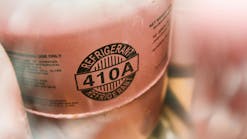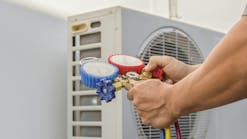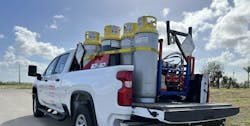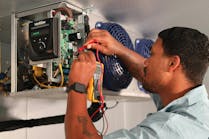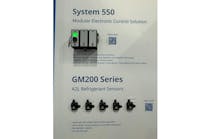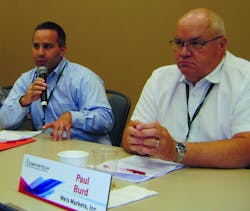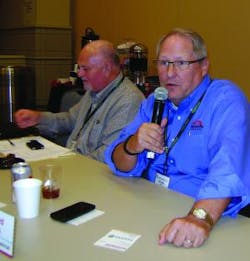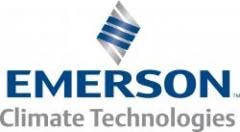No supermarket is an island.
While it would be great to isolate food storage cases and coolers from the temperature stresses of the "outside" world, it’s an unrealistic proposal. Constantly-opening case doors, shopping traffic, and high outdoor temperatures pose significant challenges for supermarket managers and refrigeration contractors, but there are ways HVAC and refrigeration can work together to better control the store’s humidification and temperature.
Our Fourth Annual Refrigeration Roundtable — which convened during Comfortech 2013 in Philadelphia, PA, included a discussion on controlling the building envelope and improving energy efficiency.
“The single most effective solution I’ve found is to use a dedicated outdoor air system (DOAS),” said Harrison Horning, director of energy and facilities for Hannaford Brothers.
“We only bring in outside air mechanically, through one system. When there’s any humidity outside, that coil is always cold. We eliminated those times when you could be bringing in outside air across a DX coil that’s turned off, so the coil is always cold. The humid air remains outside.”
“Handling humidity with a DOAS is the most effective way to control humidity in the store,” agreed Steve Hagen, procurement manager, Sprouts Farmers Market. “I have also had success using Airius fans to stratify the air in the building. It has a huge impact on humidity, in areas where you fail to recognize the need for an outdoor humidity control system.”
Paul Burd, manager of refrigeration and store service for Weis Markets, said a DOAS has a huge effect on reducing the number of store defrost cycles, and anti-sweat cycling.
“We’ve gone the route of putting destratification fans in our stores. We found that starting at the ground floor level and going up about 1.5 to 2F per foot, temperature increases. The fan moves that air down and stirs it up. That’s the best dehumidification, when you address the entire building envelope.”
Burd also spoke highly of the benefit of variable speed motors on condenser fan air handlers, depending on store conditions.
Adding commercialized kitchens, which are found in more modern supermarkets, poses the challenge of what to do with kitchen exhaust. Brad Morris, manager of engineering for Giant Eagle Stores, said kitchens are increasing the amount of outside air in stores. “Having one unit to focus on and remove moisture allows us to focus on energy reductions during off-peak hours,” he said. He continued to say he has tried desiccants for humidity control, but switched to a DX system eight years ago. “From a contractor’s perspective, it was easier to maintain that type of technology over the desiccant, strictly around reducing operating costs,” he shared.
Contractor Joe Gallego, special projects manager for Bay State Cooling, Bridgewater, MA, said many store chains are missing the boat when it comes to designing their HVAC systems.
“They design a nice refrigeration system with a separate engineer, and then have an architect design a vanilla, box-type retail store with X amount of cooling, and it doesn’t always work so well,” Gallego said. “They split out their engineering into ‘refrigeration’ and ‘building,’ and are using 75F/55F design conditions. Nobody hands that to the architect who is designing the HVAC system for the building and they look at maximum occupancy, how much outside air has to come in, and none of that gets taken into consideration: that there’s a refrigeration system operating in the building as well. And, with the additional cooling from the cases, the DX units short-cycle, and don’t run long enough to dehumidify the building.”
On the upside, Gallego says he sees more industry professionals taking action and providing humidity control in their stores, which is a step in the right direction.
“You’ve got to take the refrigeration system and the design conditions of cases into consideration,” he said.
“Dry air costs money,” said contractor Frank Vadino, vice president of engineering for Cold Technology, based in Blackwater, NJ, and he added that doors on cases might not be an answer.
“It costs money to have dry air in a supermarket. To us, the question is, what’s the most cost effective way to obtain dry air in a food store? With advances in supermarket refrigeration, the proliferation of glass doors can actually have an adverse effect on our ability to control humidity. It puts pressure on the need to have humidity controls in stores because of all the glass surfaces,” Vadino said. “When you introduce more glass doors into a store, you have fewer case credits, which helps from an efficiency standpoint, because you’re not dehumidifying at the lower evaporating temperatures of low temp or medium temp refrigeration. It’s necessary to ensure that you have a dedicated air system."
Vadino shared with the panel of store managers, contractors and sponsors that Cold Technology has used an integrated design approach, with desiccant systems in conjunction with direct expansion (DX) systems, to supplement the ability to maintain dry air in stores during times of high humidity.
Steve Wright, president,Wright Bros. Inc., Griffin, GA, said there can indeed be a disconnect between HVAC contractors and store refrigeration teams.
“Most of the time, we’re able to work around where we’re back in the saddle of handling both of those issues, because they’re critical. If they fall out of balance, you will have case sweating and other issues,” he said. “Many stores have used the traditional, ‘large environmental system: a rooftop unit that controls the entire store environment. It does a good job when left alone, until people start messing with it.
“For instance, if it has a split return, they’ll start fiddling with the outdoor air, changing the split on the return, and some other issues, bypassing the coolant coil differently because of whatever they think isn’t working at the time. Those things have to be kept in line.”
Wright said the firm’s legacy stores have rooftop units with virtually no dehumidification control, and fans are used to eliminate localized high humidity buildup.
“We were able to use anti-sweat heater cycling of those devices, and are saving a substantial amount of money from cycling anti-sweat heaters and those types of things. We also have used fans for certain ‘stagnant air spots,’ to circulate the air,” Wright said.
COMING IN FEBRUARY: ADVANCES IN HEAT RECLAIM
Our 2013 Refrigeration
Roundtable Panel of Experts
SUPERMARKET REPRESENTATIVES:
Harrison Horning, director of energy and facilities, Hannaford Brothers.
Paul Burd, manager, refrigeration and store service, Weis Markets.
Brad Morris, manager of engineering,
Giant Eagle.
Steve Hagen, procurement manager,
Sprouts Farmers Market.
CONTRACTOR REPRESENTATIVES:
Steve Wright, Wright Bros., Inc., Griffin, GA
Pete Savage, AAA Refrigeration Services, New Jersey branch
Richard Luhm, Memphis Mechanical,
Memphis, TN
Joe Gallego and Dave Kjelgaard, Bay State Cooling, Bridgewater, MA
Frank Vadino, Cold Technology, Blackwater, NJ
SPONSOR REPRESENTATIVES :
Masood Ali, Heatcraft Worldwide
Refrigeration
Dustan Atkinson, Derrick Echols, Dale Sizemore, Nate Sung, Kysor/Warren
Tim Beck, John Post, Resource Data
Management
John Gallaher, Hillphoenix
Steve Hale, Jonathan Holloway, Bruce Parsons, Jeff Staub, Danfoss
Travis Lumpkin, David Lee, Tim Ryan,
Norm Street, Hussmann Corporation
THE REFRIGERATION ROUNDTABLE
WAS SPONSORED BY:

